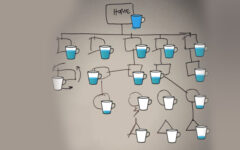Correlation has always been a methodology for SEOs to discover and collect correlates, which are measurements that share a relationship with the independent variable. For example, speaking of rankings, we know that backlink counts and social shares are correlates of ranking order. Correlation also helps us with the direction of a relationship – direct or inverse proportions – and can also help us rule out proposed ranking factors. You must remember that research that provides a negative result is also as valuable as research that provides a positive result.
With the above understanding, we now know that a variable can predict a future change for sure. This is the foundation upon which the below mentioned correlation model is built. Instead of measuring the correlation between links/shares with a SERP, it could be beneficial to measure the correlation between these factors with the changes observed in SERPs over time.
For this, you first need to collect a SERP. Then, you need to collect the link counts for each URL in the SERP. Here, you must look for any URL pairs that are out of order, with respect to links, and record the anomaly. Do the same review after a fortnight, and check if the anomalies have been corrected. You can do this across thousands of keywords and test a number of different factors. With this study, we can analyze if a particular ranking factor is a leading or lagging element. A lagging factor can there and then be automatically ruled out.
With this methodology, various elements like Facebook shares, Page Authority, and number of root linking domains, can be tested.
Facebook shares – Facebook shares perform the worst of all, meaning that randomly selected pairs are more likely to switch than those where shares of the second were higher than the first. This proves that social signals are lagging factors. After all, it is traffic from higher rankings that drives higher social shares; and not social shares that drive higher rankings.
Page Authority – This is the highest performing factor among all. This is a strong leading factor that greatly outperforms Facebook shares and root linking domains. After all, Page Authority is built to predict rankings, thus it definitely has to outperform other factors.
Number of root linking domains – This performs better than Facebook shares. However, the analysis with root linking domains is incredibly subtle as it only detects when a factor is leading, and when Moz Link Explorer discovers it before Google does. Therefore, here the results prove to be statistically significant.
Hence, we can see how we can get amazing results with the correlation model. However, this is only one method that can help find out the differences between ranking factors and lagging correlates. Other methods like machine learning and statistics can also prove to be promising for improving predictive models. To learn more about them, or in fact, leave it all in the hands of professionals, you need to hire a reputed digital marketing company in Bangalore to help you with the task.




